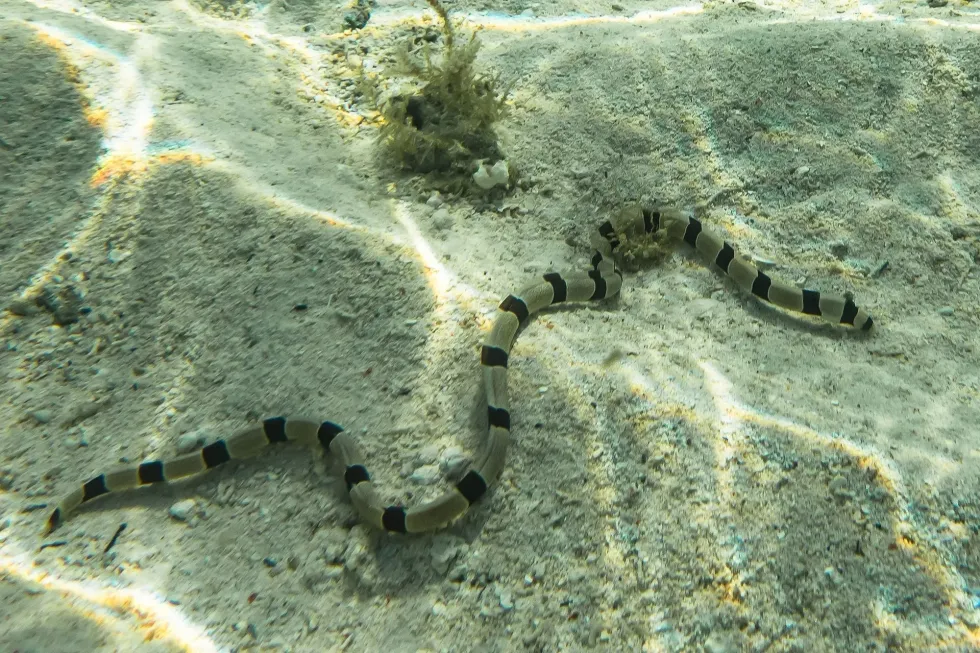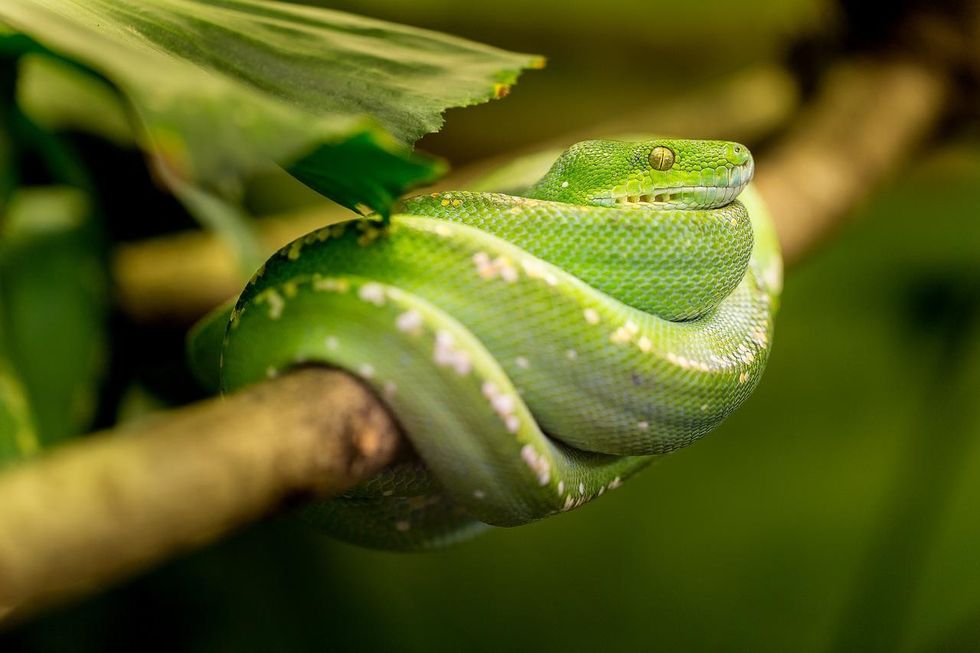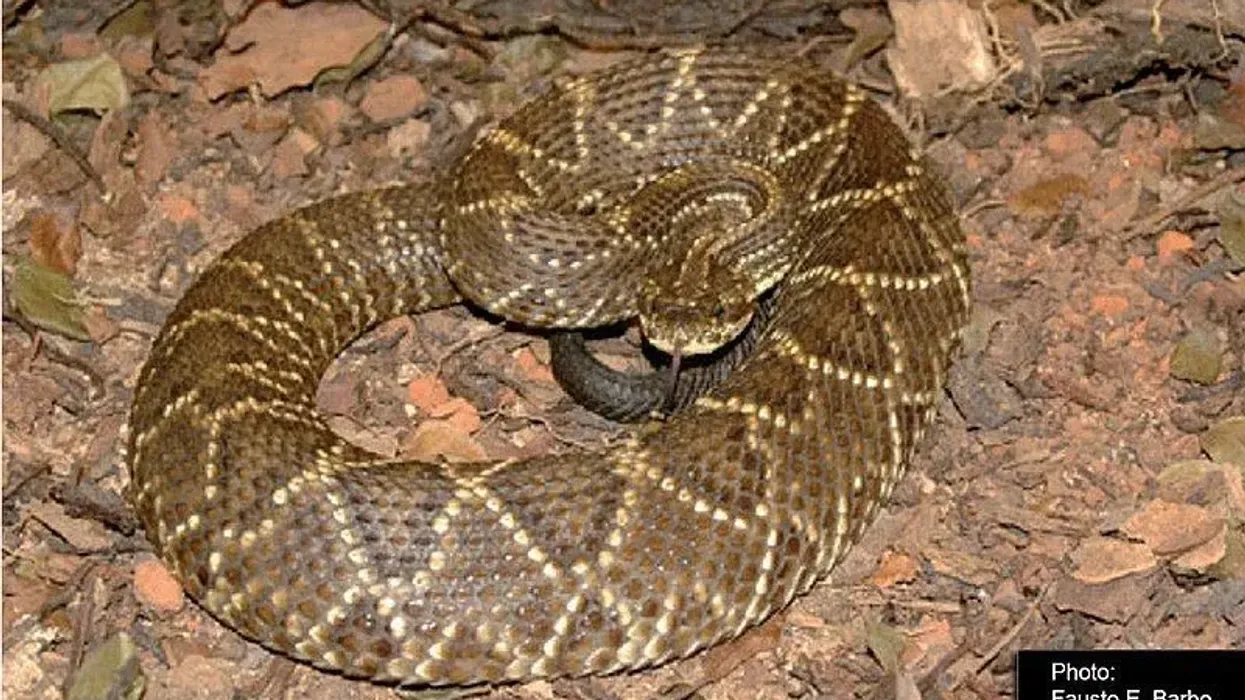The banded snake eel belongs to one of the 500 species of eels and these species are are further divided into 20 families. The Banded snake eel, (scientific name: Myrichthys colubrinus), known also by the names harlequin eel and ringed snake eel, is a member of the family Ophichthidae.
Moray eels (Family Muraenidae) are the most common ones and are usually found in the home aquaria trade.
A banded snake eel can be easily recognized by its coloration and slender body. It is usually white with 25 to 30 black colored bands covering its body.
Unlike many other snake eel species that are nocturnal, these eels are sometimes seen foraging during the daytime and resting during the night. The banded snake eel has a sharp head with a pair of extended tubular snouts on its overhead jaw.
These point downward and help provide the eel with an excellent sense of smell, allowing it to explore for prey hidden under the sand.
As this fish has poor vision, it uses its sharp sense of smell to hunt small fish and crustaceans. Interestingly, snakes and eels are not related at all.
If you liked these facts about the banded snake eel, then you'll surely like these facts about the conger eel and ribbon eel too!
Banded Snake Eel Interesting Facts
What type of animal is a banded snake eel?
The banded snake eel (Myrichthys colubrinus) is a type of fish from the family Ophichthidae.
What class of animal does a banded snake eel belong to?
The banded snake eel (Myrichthys colubrinus) belongs to the class of Actinopterygii (ray-finned fish).
How many banded snake eels are there in the world?
Due to a lack of data, the total population of banded snake eels is unknown.
Where does a banded snake eel live?
The banded snake Eel (myrichthys colubrinus) is native to the Indo-Pacific range. They are found from Delagoa Bay of Mozambique to the south of the Red Sea and to the east of the Society Islands of French Polynesia.
What is a banded snake eel's habitat?
The ringed snake eel is a burrowing species that live in sandy regions of inshore waters and coral reefs. These fish are found in the depthless sandy flats and seagrass beds.
Who do banded snake eels live with?
The banded or harlequin snake eel is a solitary creature that likes to spend its time hidden under the burrow, hunting alone.
How long does a banded snake eel live?
The banded or ringed snake eel has an average lifespan of 10 to 15 years in the wild. This can be extended up to 20 years in captivity by proving better care and a proper diet.
How do they reproduce?
The mating process of this species has not been well studied and this has meant there is not much information on their sexual maturity age, egg clutch size, mating patterns among males and females, or their nesting behaviors.
What is their conservation status?
There is not much information regarding the population count of this species and they have not been on the IUCN Red List.
Banded Snake Eel Fun Facts
What do banded snake eels look like?
The harlequin snake eel has a meandering-shaped body and has a white base color that features a set of 25 to 30 evenly ranged, well-marked dark brown rings. The dorsal fin of this fish is outstanding and reaches down the back.
These snake eels have declined and outer projecting nostrils that help them in transversing swiftly across the depth of the reef when they are foraging for prey. Their smell-based hunting is further concentrated on the coral reef bed.
Their slightly outer projecting nostrils enable greater efficiency while hunting for prey. These eels have a blunt head and comparatively small eyes which do not help when looking for prey. They primarily use their nostrils to hunt.

How cute are they?
The harlequin snake eel is very cute in its appearance as it has a white base color with equally spaced black bands around its body.
How do they communicate?
Harlequin snake eels are solitary in nature. They communicate with other species mostly by using chemicals that are released by them, or by touch.
How big is a banded snake eel?
The harlequin snake eel is a small snake eel species and it can grow up to 34.6- 38 in (88-97 cm) in length. These snake eels are double in length size of spotted garden eels and one third of the length size of electric eels.
How fast can a banded snake eel swim?
The ringed snake eel is found on the reef of indo-pacific regions, moving slowly in search of food. If they sense predators these snake eels can swim at the speed of 2.5 mph (4 kph).
How much does a banded snake eel weigh?
The ringed snake eel is a small snake eel that can grow up to 1-25 lb (0.4-11.3 kg).
What are the male and female names of the species?
No specific names have been assigned to the males and females of this species.
What would you call a baby banded snake eel?
No specific name is given to baby banded snake eels. These young fish develop black spots between their rings as they age.
What do they eat?
Banded snake eels are carnivorous and their diet mainly consists of other small fish, shrimp and crab among other crustaceans.
Are they dangerous?
Though the banded snake eel impersonates a very venomous banded sea krait, they are neither poisonous nor venomous.
Would they make a good pet?
Yes, the banded snake eel does make a good pet. It is very easy to care for the banded snake eel care as they are peaceful creatures hiding mostly under the sand and these fish do not need excessive water change.
These fish require a medium-size tank or aquarium setup of up to 90 gal (341 l). Sand is the only substrate that should be used to make an artificial coral reef aquarium bottom.
Rocks should be put on top of the sand so these eels can bury themselves and hide. These eels thrive well in a temperature range of 74-79 F (23-26 C) in an aquarium.
As these eels are carnivores, and their feeding habit is unique as they do not overeat, you can feed them a mixed diet of small chunks of fish flesh, shrimp, and scallops, silversides, and krills. This fish should not be kept with small tank mates as it might try to swallow the smaller tank mates.
Did you know...
Banded snake eels are immune to diseases, no recorded diseases are known.
These fish swim low in the depths of the bottom reef, searching small cracks and holes for prey to feed on, such as small crustaceans. Sometimes these fish are found stored in the decayed bodies of larger fish, apparently having been swallowed. They sometimes use their pointed tail to burrow out of the stomach.
Interestingly, sea snakes are known to eat a wide variety of eels.
The largest eel is the conger eel which belongs to the Conger genus of eels. It can grow up to 5-7 ft (1.5-2 m) in body length and weigh up to 159 lb (72 kg).
What is the difference between a sea snake and an eel?
Snakes and eels are not related. Sea snakes appear to be more like a swimming rope in shape, movement, and texture, while an eel appears more like a ribbon.
The body of a sea snake is cylindrical, similar to any other snake species, but the head may have a flatter shape. The tail end of the sea snake is usually paddle-shaped, which helps them to move through the water.
Eels are a distinct type of extended fish which are found in both marine and freshwater habitats. These fish usually have a much vertically flatter body, and the head tends to be sharper and longer.
Eels also have fins, which a sea snake does not possess. These fins are usually positioned along the top or bottom of the eel's body or extend from behind the head.
Although both sea snakes and eels have scales, they are different in their own way. The scales of a snake are much simpler to see as the pattern is clearly visible. The eel’s scales are much more petite, giving them a smoother surface.
Do eels bury themselves?
Yes, eels do bury themselves under sandy and muddy beds to hide, surprise and attack their prey. The tail of the banded snake eel is strengthened and piercingly pointed for burrowing tail-first into the sandy bed.
Here at Kidadl, we have carefully created lots of interesting family-friendly animal facts for everyone to discover! Learn more about some other fish from our queen snapper fun facts or raccoon butterflyfish interesting facts pages.
You can even occupy yourself at home by coloring in one of our free printable moray eel coloring pages.









